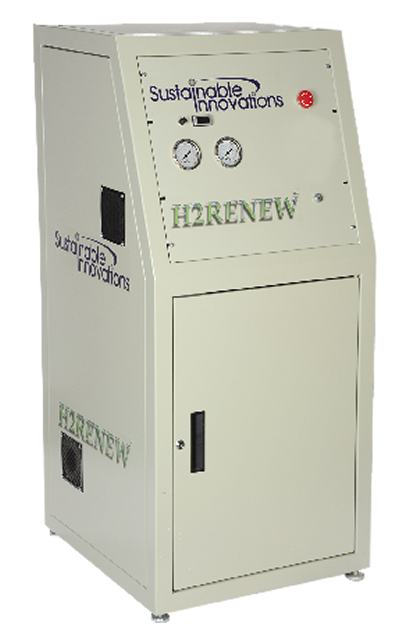
Helium Recapture System Reclaims Hydrogen for Industry Use
NASA Technology
Rising helium prices might not put much of a dent in the average birthday party balloon budget, but they add up quickly for an organization like NASA, which uses up to 100 million cubic feet of helium each year. A new technology developed with NASA funding, however, will not only allow the Agency to reuse its helium but also let various industries recapture the hydrogen used in processes like treating metal and making glass or silicon.
NASA uses helium to purge hydrogen lines around launch pads and rocket test stands, explains Jonathan Dickey, engineer with the Mechanical Design Group at Stennis Space Center, the largest rocket test facility in the United States. “Our main propellant is liquid hydrogen, and we do a pretty brisk business in the stuff.”
The hydrogen is brought by barge or tanker truck and piped to test stands in liquid form through flexible lines. Any hydrogen left in the lines quickly turns to gas, which, being highly flammable, has to be blown out before the lines are disconnected. Due to the cryogenic temperatures, though, blowing air—or most other gases—through the lines is impossible.
“Air would solidify into blocks of solid oxygen and nitrogen,” Dickey explains. “Helium is the only element that liquefies at a lower temperature than hydrogen, so we can use it and it will still be a gas.”
Until now, the two mixed gases have been blown out of flare stacks, where the hydrogen is burned off. But in 2009, with a 1996 law that would take the Federal Government out of the helium business scheduled to finally begin taking effect, NASA put out a call for proposals for a technology that would make the Agency less susceptible to rising helium prices.
Among those who responded was Trent Molter. Having previously founded Proton Energy Systems, now Proton OnSite, a company that manufactures hydrogen, nitrogen, and zero-air generators, and working on his doctorate in fuel cell technology, Molter had recently founded Sustainable Innovations, LLC, which is based in East Hartford, Connecticut, and focuses on clean-energy technology. His company had been developing a reverse form of fuel cell technology that would use an electrical charge to separate and purify hydrogen, whereas an actual fuel cell combines hydrogen with oxygen to create a charge.
“It was really all about thinking of new ways to apply existing fuel cell technology to create new products,” Molter says.
Technology Transfer
Stennis was interested and entered into a Small Business Technology Transfer (STTR) contract with Sustainable Innovations, with Dickey acting as the technology monitor. The following year, Stennis awarded the company a Phase II STTR contract to build a prototype for the system.
While Sustainable Innovations had tinkered with the technology previously, Molter says, “The Stennis application was the first time we wrapped a full system around it, so that was a huge stepping stone for us.”
At the heart of the system is the same proton exchange membrane technology used in hydrogen fuel cells, but in this application, a charge applied to electrodes on either side of the cell drives hydrogen protons through the membrane, while electrons loop across through an external circuit, and the gas is recombined on the other side, leaving any other elements behind. In the case of NASA’s hydrogen lines, the only other element present is helium, which is then stored for reuse.
“The Stennis people care about the helium more than the hydrogen,” Molter says.
Others, however, care plenty about the hydrogen.
Benefits
Hydrogen is used in several industrial processes, especially for the removal of oxides from steel, glass, and semiconductors such as silicon wafers. The gas combines with any oxygen in the substance and carries it off in the form of water.
“People use a lot of hydrogen for these applications,” Molter says, estimating the near-term market at around $100 million annually. “And they vent the hydrogen they don’t use. We can essentially scoop up the vented hydrogen and clean it up.” The gas can then be reused at low cost.
As hydrogen fuel cell technology continues creeping toward the critical mass that would roll it into the mainstream, Molter sees a major additional use for all the hydrogen that’s currently going to waste. The energy market for hydrogen could be up to $50 billion per year, he says. “There are a lot of uses for hydrogen in energy, beyond cars. Some are largely undefined, and some are being defined now.”
A major advantage of Sustainable Innovations’ first commercial product, called H2RENEW, is that it not only separates and cleans hydrogen but also simultaneously pressurizes it for storage, giving the technology a two-for-the-price-of-one quality. “Conventional hydrogen compressors are separate devices from the hydrogen recycling unit, and they rely on rotating machinery,” Molter says. “So ordinarily you would have two large, expensive pieces of equipment to provide both functions.” In H2RENEW, though, as long as the voltage is applied, the electrochemical separation process continues, and hydrogen is pushed into the storage tank to the required pressure.
“Each device on its own is interesting, but when you combine the functions, that makes it really exciting,” he says. He also envisions a compressor using the technology: “This product, in some rendition, would be able to separate hydrogen made through other means and compress the hydrogen that would be fed into a vehicle.”
The existing machine is also modular, so units can be stacked to meet capacity requirements.
Sustainable Innovations is also in the process of patenting two methods that allow the technology to work with highly contaminated gases that would hinder performance in any conventional fuel cell technology. “It allows us to operate with some pretty nasty feed gases,” Molter says.
Further STTR contracts and Small Business Innovation Research contracts with various other NASA field centers have continued to advance the technology.
The company, which now has about 16 employees, also has two more products in the pipeline, based on the same electrochemical platform. The HALO-GEN, based on reversible hydrogen/bromine chemistry, is planned to be a low-cost, high-efficiency battery that would allow a “smart grid” powered by wind or solar energy to provide a constant power supply, even in the absence of wind or sun. The system’s energy storage component is projected to cost less than half that of the best competition under development. And CO2RENEW would harness carbon dioxide waste emissions, electrochemically converting the greenhouse gas into useable chemicals and hydrocarbon fuels.
“The platform for the other two products is very similar, so we’re really leveraging the work we did on the NASA product,” Molter says. “If we achieve a higher efficiency with one product, oftentimes we can achieve the same benefit across the board.”
At Stennis, the helium recapture system was tested and validated by spring of 2015 and was expected to be permanently installed and in use by the end of the year.
“On an average year, if we can recapture and reuse all the helium, it would save hundreds of thousands of dollars,” says Dickey.
Molter says the NASA-funded work not only got the technology off the ground but also helped to make it credible as a commercial product. “We brought the very first unit we built under the STTRs to some commercial customers and did a show-and-tell and collected data, and that’s helped with our fundraising and commercial partnering,” he says. “I think this is an example of one of those projects that work out really well for both sides.”

Sustainable Innovations took a technology it created to allow Stennis Space Center to reuse helium and applied it to the recapture, cleaning, and pressurizing of hydrogen used in industrial processes, saving companies money. In addition to H2RENEW, the company is planning two more devices based on the same electrochemical platform, a sort of reverse hydrogen fuel cell technology.

Stennis Space Center is in the business of testing rocket engines, which requires cryogenic liquid hydrogen and oxygen to be piped to rocket test stands. Helium, being the only element with a lower freezing point than hydrogen, is then used to blow any residual hydrogen out of the lines. Sustainable Innovations’ hydrogen capture technology will allow that helium, which is set to increase in price as the Federal Government gets out of the helium business, to be isolated, stored, and reused, saving the center hundreds of thousands of dollars a year.













